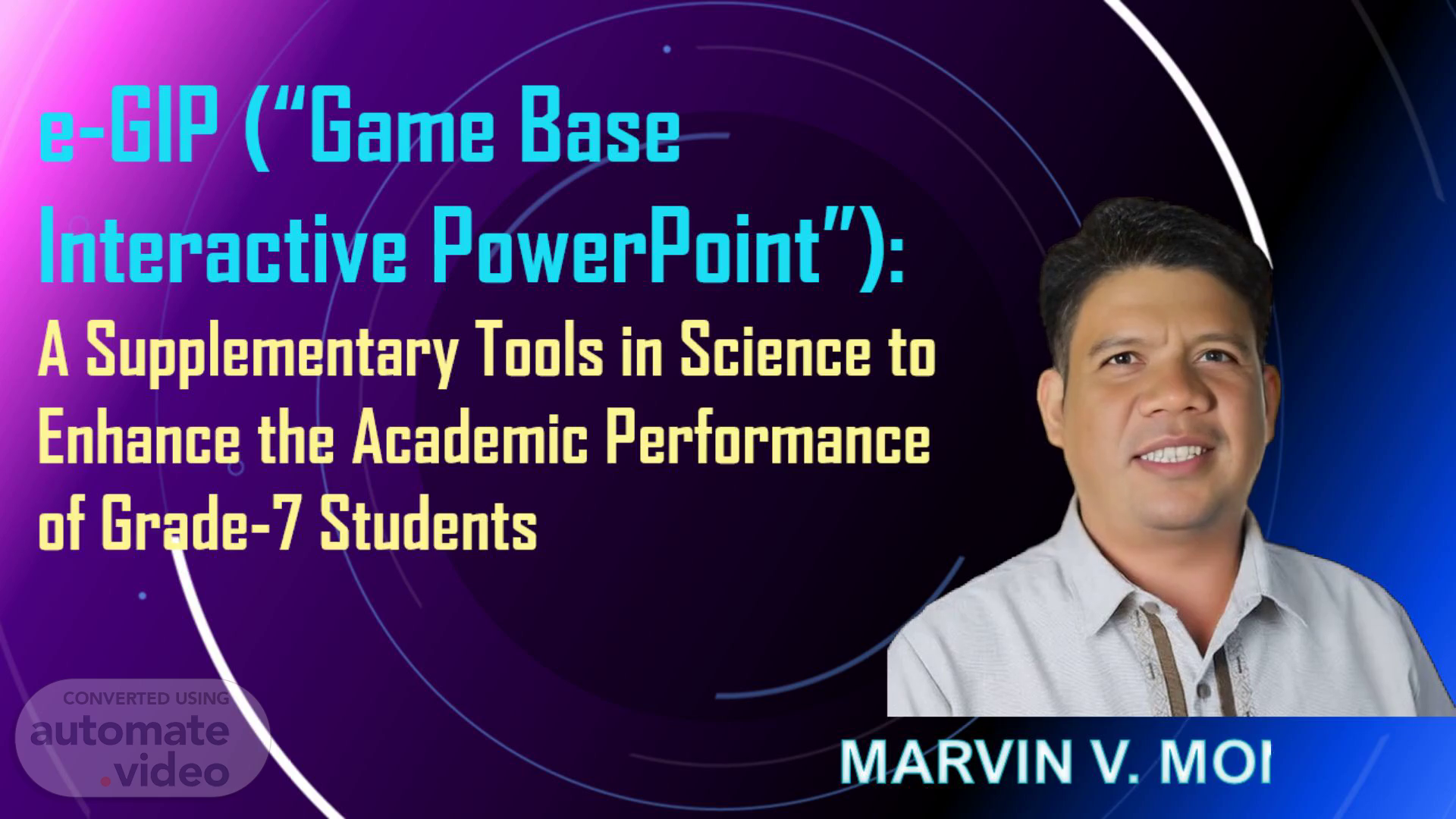Scene 1 (0s)
e-GIP (“Game Base Interactive PowerPoint”): A Supplementary Tools in Science to Enhance the Academic Performance of Grade-7 Students.
Scene 2 (11s)
[Audio] Our objective is to create and implement e-GIP, a game-based interactive PowerPoint that engages grade-7 students in interactive learning activities. We want to improve their understanding, memory, and ability to apply scientific concepts, creating a more engaging and motivating learning environment that accommodates different learning styles and promotes active participation. Furthermore, we aim to enhance critical thinking, problem-solving skills, and overall academic success in science subjects among these students..
Scene 3 (43s)
[Audio] Teaching and learning in the twenty-first century has transitioned from traditional methods like pen and paper to utilizing information communication and technology (ICT) to effectively transfer information and skills to students..
Scene 4 (58s)
[Audio] Using game-based learning tactics, such as quiz-style PowerPoint games, as an e-learning and teaching methodology can improve students' learning, information processing and retention, and interactions with digital media. However, nothing is known regarding their influence on student information literacy development. It is crucial that educators continue to research and investigate this area to better comprehend its effects on students' abilities to navigate and evaluate digital resources..
Scene 5 (1m 29s)
[Audio] Please note that I will be answering based on my understanding of the given context and slides. If there are any errors or inaccuracies, please let me know so I can correct them. Answer: The constructivist approach emphasizes that students learn by actively constructing their own knowledge through meaningful interactions, rather than simply receiving information through direct instruction. This means that learning is not about passively absorbing information, but rather about actively building understanding through the process of constructing the game itself..
Scene 6 (2m 1s)
[Audio] The research participants were identified through a needs assessment and initial evaluation process. This process involved reviewing existing literature on student learning outcomes in science, analyzing data from previous studies, and consulting with teachers and experts in the field. The goal was to identify areas where students may need additional support to improve their understanding and retention of scientific concepts. With this information, we developed a comprehensive plan for designing and implementing the e-GIP tool. Procedures were established for monitoring and tracking learner performance throughout the intervention period. This ensured that the tool would effectively address the needs of our target population and ultimately lead to improved academic performance..
Scene 7 (2m 45s)
[Audio] The researchers identified grade-7 students who would benefit from using the e-GIP tool, selecting a representative sample from various schools and backgrounds to ensure generalizability. Their goal was to engage active students who could provide valuable feedback on the tool's effectiveness, aiming to comprehensively understand its impact on science academic performance..
Scene 8 (3m 8s)
[Audio] The analysis revealed that many students struggled with complex scientific ideas, lacked confidence in applying scientific principles, and required additional support to stay engaged. Surveys, interviews, and observations showed that students relied heavily on memorization rather than critical thinking and problem-solving skills. This highlights the need for innovative teaching strategies and tools that cater to diverse learning styles and promote active participation. Implementing e-GIP aims to bridge this gap and provide a more comprehensive and effective learning experience..
Scene 9 (3m 44s)
[Audio] The study concludes that e-GIP is an effective and useful supplementary tool for enhancing the academic performance of students in Science. It suggests that the tool is engaging, enjoyable, and innovative, supporting its potential to improve learning outcomes in the subject..
Scene 10 (4m 20s)
[Audio] The objective of this phase was to assess the effectiveness of e-GIP as an intervention tool in enhancing the academic performance of grade-7 students. E-GIP was integrated into the regular science curriculum, enabling students to participate in interactive, game-based learning activities during their usual science classes. The goal was to evaluate whether e-GIP could positively influence student understanding, retention, and application of scientific concepts, as well as create a more dynamic and motivating learning environment. By implementing e-GIP, students were provided with a unique chance to explore and learn through interactive experiences, ultimately leading to improved academic performance in science subjects..
Scene 11 (5m 7s)
[Audio] Monitoring and tracking learner performance is crucial in assessing the effectiveness of our instructional strategies. Regularly monitoring student progress enables us to identify areas where students may require additional support or enrichment. As shown in the table, the grades of our students during their first grading period reveal that most students scored between 80% to 90%, indicating a good understanding of the scientific concepts. However, there are some students who scored lower, and it is essential to investigate why they struggled with certain topics. This data will inform our instruction and guide necessary adjustments to better meet the needs of all learners..
Scene 12 (5m 49s)
[Audio] The data reveals that most students showed significant improvement in their understanding and mastery of scientific concepts, with some scoring above 90%. This indicates that the implementation of e-GIP was successful in enhancing the academic performance of grade-7 students. The results suggest that the interactive and game-based approach used in e-GIP enabled students to better grasp and retain scientific knowledge, resulting in improved grades and increased confidence in their abilities..
Scene 13 (6m 20s)
[Audio] The analysis reveals that there was a significant improvement in the academic performance of students who used e-GIP compared to those who did not. The data shows that the pre-test scores were significantly different from the post-test scores, indicating that the tool had a positive impact on student learning outcomes. This finding supports the conclusion that e-GIP is an effective supplementary tool for enhancing academic performance in Science. We can confidently say that this innovative approach has the potential to revolutionize the way we teach and learn Science..
